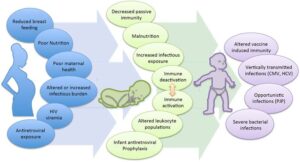Back to: MICROBIOLOGY 100 LEVEL
Welcome to class!
Hello, super scholar! I’m so happy to see you back again, ready to learn something exciting. You’re doing an amazing job, and today we’re going to learn about three very important ideas in microbiology—Infection, Disease, and Immunity. These are concepts that affect every single person on the planet, and understanding them will help you see how your body stays healthy and fights off harmful invaders.
Concepts Of Infection, Disease, And Immunity
Concept of Infection
Let’s start with infection. An infection happens when microorganisms like bacteria, viruses, fungi or parasites enter the body, multiply, and begin to live and grow inside. Not all infections cause harm immediately. Sometimes your body controls them before they cause problems.

Example: If you drink dirty water and bacteria like E. coli get into your stomach, they can begin to grow and cause infection. But if your immune system is strong, you might not even feel sick.
Types of Infection:
Local infection: Affects only one part of the body (e.g. a boil).
Systemic infection: Spreads through the whole body (e.g. malaria, typhoid).
Concept of Disease
Now, what is a disease? Disease occurs when an infection causes damage to the body, leading to symptoms like fever, cough, rashes, diarrhoea, or pain. It means the body is no longer functioning normally.
Not all infections lead to disease. But when they do, the signs show that the body is under attack and needs help.
Example: You can carry the bacteria that cause tuberculosis (TB) without getting sick, but if your body becomes weak, the infection can turn into full-blown disease with cough and chest pain.
Communicable vs. Non-communicable Diseases:
Communicable diseases are spread from person to person (like flu, COVID-19).
Non-communicable diseases are not caused by infections (like diabetes, asthma).
Concept of Immunity
Now let’s talk about your body’s superhero—immunity. Immunity is the body’s ability to defend itself against infection and disease. It’s like having soldiers inside your body (white blood cells) that fight off germs.
There are two main types:
Innate immunity: What you’re born with. It gives quick, general protection.
Acquired immunity: What you gain over time, either from having a disease or through vaccination.
Example: When you get vaccinated against polio or COVID-19, your body learns how to fight those specific germs. If they try to enter again, your body is ready!
Natural vs Artificial Immunity:
Natural: Comes from recovering from an illness.
Artificial: Comes from vaccines or antibodies given by injection.

Think of infection like someone sneaking into your compound. If they start breaking things, that’s disease. But if your security guards (immune system) catch them early and throw them out, that’s immunity at work!
Summary
- Infection is when germs enter and begin to grow in the body.
- Disease is when the infection causes harm or symptoms.
- Immunity is the body’s defence system that protects against infection and disease.
- Immunity can be natural or acquired, and vaccines help build it.
Evaluation
- What is the difference between infection and disease?
- Give one example each of a local and a systemic infection.
- What is immunity?
- Name two types of immunity.
- How does vaccination help your body?
Understanding infection, disease, and immunity makes you wiser about how your body works and how to protect it. Keep shining and learning with Afrilearn—your future is as bright as the stars!
